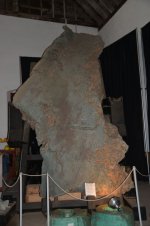T
You are using an out of date browser. It may not display this or other websites correctly.
You should upgrade or use an alternative browser.
You should upgrade or use an alternative browser.
Copper Boulders?
1. Native copper boulder weighing 17 tons on display at the Quincy Mine.

(Click on thumbnail for larger image.)
Photo by Capt. Paul & Dr. Nat Brandes, courtesy of Pasty Cam.
2. The worlds largest glacial copper boulder (28.2 tons), found in the Keweenaw, and subsequently purloined by some scurrilous scoundrels to be displayed in Presque Isle Park, in Marquette.
See and read about it here …
(click →) Past-E-Mail: Cam Notes - 2011: May: May 22-11
As I wrote in that link:

What else are you looking for?…what else ya got
1. Native copper boulder weighing 17 tons on display at the Quincy Mine.

(Click on thumbnail for larger image.)
Photo by Capt. Paul & Dr. Nat Brandes, courtesy of Pasty Cam.
2. The worlds largest glacial copper boulder (28.2 tons), found in the Keweenaw, and subsequently purloined by some scurrilous scoundrels to be displayed in Presque Isle Park, in Marquette.
See and read about it here …
(click →) Past-E-Mail: Cam Notes - 2011: May: May 22-11
As I wrote in that link:
The largest piece of float copper known to man, which was formed in the Keweenaw peninsula, a "part of the same copper that was mined out of the Keewenaw [sic] Peninsula" and subsequently discovered either "near Calumet", or perhaps more accurately, within the "old Quincy mine holdings just a mile or so from the main mine at the top of Quincy Hill NE of Hancock". (They can't seem to get their story straight, not to mention that they can't apparently even spell "Keweenaw"!)
So of course, AAPS Board member, Carl Lindquist, executive director of Superior Watershed Partnership and Land Trust has the idea to ": move the copper to Marquette where it can be seen by thousands".
Marquette indeed! Absurd!
What better, more logical location could there possibly be to display that chunk o' copper but on top of Quincy hill, in connection with prominent landmark that is the Quincy Mine Hoist complex? What, it wouldn't be seen there? Hogwash!
Rather than go to the significant expense of moving it to Presque Isle Park, they might instead have simply moved it to the Quincy Mine site, at a significantly lesser expense, and put the difference into the preservation fund!
Apparently Mr. Rydholm would agree, as noted in this excerpt from the AAPS website:
"The general AAPS Board has been hesitant to think in terms of such a museum being located in the Keweenaw because of outside people not wanting to travel that far to get to it. Some thought such a museum should be in the UP but not so far out but closer to a larger city, for example, Marquette. Both Fred Rydholm and I [Lee Pennington] feel the museum should be located in the Keweenaw (near where many ancient copper mines are located)."
I'm offended, infuriated, irate at the disrespect for Hancock and the Keweenaw, I tell ya!
"Qwincy??? Would you believe Quincy?Qwincy [sic] mine has the biggest chunk of copper...56,400 pounds of it.

Last edited:
T
Tracker
Guest
What else are you looking for?
well it seems it was found in the same area as the Minoan ship carved on a rock (which most think is Viking but ancient texts and houses in crete say otherwise)
"It is in the New Palace period in Bronze Age Minoan Crete, that we find a large increase in population, particularly in settlements along the coasts, the growth of towns, which in some cases surround mini-palaces, luxurious separate town houses at palatial and other sites, and fine country villas ... Villas and houses at Ayia Triadha and Tylissos contained not only weights and loom weights, but also copper oxhide ingots and Linear A tablets, and both are rich in luxury products and bronze objects. Minoan prowess in metal weapon production was not limited to the long sword, but included the short sword, the solid long dagger and the shoe-socketed and tube-socketed spearhead and arrowhead, all of which may have made their first Aegean appearance in Crete" ... Neopalatial Crete is extremely rich in bronze, but very poor in sources of copper and of course totally lacking in sources of tin" (Ref.23). The Newberry Tablet of Newberry, Michigan (Fig.6) is in a Cypriot/Cretan sylabary. Cretan script may have been the basis of the Cree sylabary (Ref. 7), and Mayan writing (Ref.3). The "Cavern of Glyphs" on the Ohio River had images of clothed figures that "singularly recall the dress of the Minoans, as seen on the frescoes at Knossos in Crete" (Ref.79). A Minoan pot has been unearthed in Louisiana. The Olmecs laid mosaic tiles at La Venta, (Mexico) upon asphalt, the same technique used in Crete (Ref.3). The excavation of the wealthy grave goods at Hallstatt (see Fig.5) show that traders brought Minoan pots as well as copperlbronze pots to trade for salt. It appears that the ruling elite of Hallstatt were among the end customers of Michigan copper, as well as the Egyptians.
Michigan Copper in the Mediterranean
(Isle Royale and Keweenaw Peninsula, c. 2400BC-1200 BC)
T
Tracker
Guest
Silver in the Copper
Pieces of the "native" Michigan copper sometimes have .crystals of silver inclusions, mechanically enclosed but not alloyed; this is called "halfbreed copper". In the commercial mines, the miners are said to have cut these silver nodules off with knives, and take them home. The presence of silver nodules in "Old Copper Culture" tools shows they were made by hammering, called "cold working". These hammered weapons and tools found in Hopewell mounds sometimes "show specks of silver, found only in copper of Lake Superior" (Ref. 69). Apparently, one instance of identification by silver inclusion has occurred overseas: In this letter of December 1St, 1995, Palden Jenkins, a historian from Glastonbury, writes, "I met the farmer who owns the land on which a megalithic stone circle is, called Merry Maidens, in far west Cornwall. While clearing hedges, he discovered an arrowhead, which was sent to the British Museum for identification. The answer returned: '5,000 years old; source, Michigan, USA'." (Ref.76).
Pieces of the "native" Michigan copper sometimes have .crystals of silver inclusions, mechanically enclosed but not alloyed; this is called "halfbreed copper". In the commercial mines, the miners are said to have cut these silver nodules off with knives, and take them home. The presence of silver nodules in "Old Copper Culture" tools shows they were made by hammering, called "cold working". These hammered weapons and tools found in Hopewell mounds sometimes "show specks of silver, found only in copper of Lake Superior" (Ref. 69). Apparently, one instance of identification by silver inclusion has occurred overseas: In this letter of December 1St, 1995, Palden Jenkins, a historian from Glastonbury, writes, "I met the farmer who owns the land on which a megalithic stone circle is, called Merry Maidens, in far west Cornwall. While clearing hedges, he discovered an arrowhead, which was sent to the British Museum for identification. The answer returned: '5,000 years old; source, Michigan, USA'." (Ref.76).
Silver in the Copper
Pieces of the "native" Michigan copper sometimes have .crystals of silver inclusions, mechanically enclosed but not alloyed; this is called "halfbreed copper". In the commercial mines, the miners are said to have cut these silver nodules off with knives, and take them home. The presence of silver nodules in "Old Copper Culture" tools shows they were made by hammering, called "cold working". These hammered weapons and tools found in Hopewell mounds sometimes "show specks of silver, found only in copper of Lake Superior" (Ref. 69). Apparently, one instance of identification by silver inclusion has occurred overseas: In this letter of December 1St, 1995, Palden Jenkins, a historian from Glastonbury, writes, "I met the farmer who owns the land on which a megalithic stone circle is, called Merry Maidens, in far west Cornwall. While clearing hedges, he discovered an arrowhead, which was sent to the British Museum for identification. The answer returned: '5,000 years old; source, Michigan, USA'." (Ref.76).
Wow, this is the most readable sentence structure you have ever posted!! Oh wait, its a copy/paste...… LOL
T
Tracker
Guest
Would you believe, people actualy have better things to do... than worry how others spell each and every word. Maybe a nice hobby or perhaps a gal friend might be good for you.
yes garageguy for some reason spelling is "tantamount" here....LOL...and now it seems I must modify my copy and pastes with dots as well.....LOL
PS...meanwhile the most important fact of mining and people from overseas where here doing this way before Columbus even discovered this land has fallen on deaf ears I guess. I wonder if that writing on the oak island rock is Minoan as is the kensington rune stone as well
We lost it!
Re (from my previous post):
We lost it!
Not to Marquette, but ultimately to some wealthy private collector near Chenzhou City, Hunan China!
This from the Ancient Artifact Preservation Society (AAPS),
(click →) "The Long Journey of World's Largest Float Copper".
China???
As (click →) ol' Yosemite Sam might say about that, (Youtube, 31 seconds).
Maybe if we send Donald Trump over to have a private "summit meeting" with this "wealthy private collector", kiss his ring, and whisper sweet nothings in his ear — as he recently did with (click →) "Rasputin", the former KGB Lieutenant Colonel, later Director of the Federal Security Service (FSB), the primary intelligence and security organization of the Russian Federation and the successor to the KGB:

Подполковник КГБ Влади́мир Влади́мирович Пу́тин
(KGB Lieutenant Colonel Vladimir Vladimirovich Putin, ca. 1980)
… and later

Директор ФСБ, 1998
(FSB director, 1998)
… our great master of the "Art of the Deal" can get that copper boulder back!
Re (from my previous post):
"This just in" (from 2017):"2. The worlds largest glacial copper boulder (28.2 tons), found in the Keweenaw, and subsequently purloined by some scurrilous scoundrels to be displayed in Presque Isle Park, in Marquette …"
We lost it!
Not to Marquette, but ultimately to some wealthy private collector near Chenzhou City, Hunan China!
This from the Ancient Artifact Preservation Society (AAPS),
(click →) "The Long Journey of World's Largest Float Copper".
China???
As (click →) ol' Yosemite Sam might say about that, (Youtube, 31 seconds).
Maybe if we send Donald Trump over to have a private "summit meeting" with this "wealthy private collector", kiss his ring, and whisper sweet nothings in his ear — as he recently did with (click →) "Rasputin", the former KGB Lieutenant Colonel, later Director of the Federal Security Service (FSB), the primary intelligence and security organization of the Russian Federation and the successor to the KGB:

Подполковник КГБ Влади́мир Влади́мирович Пу́тин
(KGB Lieutenant Colonel Vladimir Vladimirovich Putin, ca. 1980)
… and later

Директор ФСБ, 1998
(FSB director, 1998)
… our great master of the "Art of the Deal" can get that copper boulder back!
T
Tracker
Guest
unfortunately that's not the same piece as my posts....that piece was taken by the Smithsonian and tucked away so no one can see it...due to the fact that some pieces off it ended up in the Mediterranean and that contradicts the Columbus time line and the museums tenet of not collecting any OOPART that does not conform to the timeline
PS....Winston Churchill was also bombastic and considered a buffoon by all of his british peers and they did not want him in politics even....they all blocked him but the people said otherwise.....how did that turn out? I think you better read about Winston and then rethink your position as sometimes you can view the aurora but not see where it comes from...trump will be best thing happened to this country since FDR...true dat...and....the people have spoken again when logic hath evaded the current leaders
PS....Winston Churchill was also bombastic and considered a buffoon by all of his british peers and they did not want him in politics even....they all blocked him but the people said otherwise.....how did that turn out? I think you better read about Winston and then rethink your position as sometimes you can view the aurora but not see where it comes from...trump will be best thing happened to this country since FDR...true dat...and....the people have spoken again when logic hath evaded the current leaders
Yep, ol' Winnie sure put his detractors in their places!… PS....Winston Churchill …
As to Trumpski, he sure doesn't fit the "traditional" mold of "Prezunitedstates". (That's how all the "talking heads" seem to pronounce it!)
His presidency thus far seems more like a glorified new season of perhaps "The Imperial Apprentice", where his perspective seems to be solely "It's ALL about Me!", as 'Admiral Trump' steers the latter day (click →) "Trump Princess" superyacht, er … current "ship of state" on his own whim while deliberately and totally ignoring the best advice and counsel of the crew, er … Cabinet and White House staff.
All while blowing away our friends and allies and seemingly kissing up to — and unquestioningly trusting — some of the foulest dictators and would-be Latter-day Joseph Stalin wannabes. WТF?
Or so it would seem.
Who knows, maybe he can pull it off, but the watchword — to butcher Bette Davis's line, as the aging stage actress Margo Channing from "All About Eve" (1950) — may well be:
“Fasten your seatbelts, it’s going to be a bumpy ride!”
D
Deleted member 10829
Guest
As much as I'd like to comment on politics, let's not get started there. It's against the rules.
